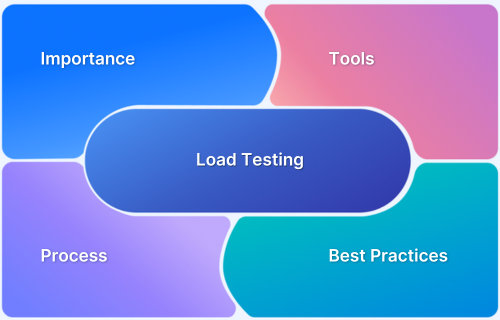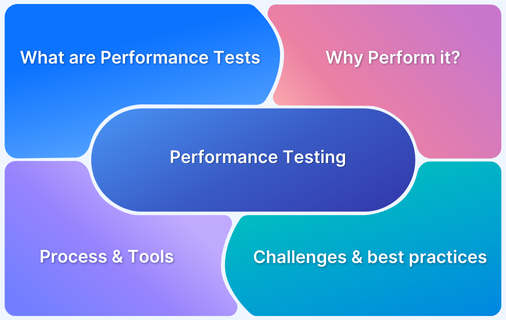Developing a functional application is only part of ensuring software quality. For long-term reliability, evaluating how the application performs under continuous, real-world usage is essential.
Overview
What is Endurance Testing?
Endurance testing, also known as soak testing, focuses on assessing the system’s stability, performance, and resource usage over extended periods.
Importance of Endurance Testing
Endurance testing helps detect memory and resource leaks, ensures consistent performance over time, and uncovers bugs that appear only after prolonged use, ensuring long-term reliability and stability.
Types of Endurance Testing
- Memory Leak Testing: Detects unreleased memory usage that can slow down or crash the system.
- Resource Leak Testing: Finds unreleased system resources like file handles or connections.
- Performance Degradation Testing: Identifies slowdowns or bottlenecks during continuous load.
- Longevity Testing: Validates system stability over long periods of normal usage.
- Scalability Testing: Measures how well the system handles gradually increasing load.
This article provides a comprehensive overview of endurance testing, key benefits, types, tools, and best practices.
What is Endurance Testing?
Endurance testing, also called soak testing, checks how well software performs when used for a long time without a break. It helps find problems like memory leaks, slow responses, or crashes that don’t show up in short tests.
This type of testing copies real-life use to see if the system stays stable and works smoothly over time.
Endurance testing is vital for systems used in healthcare, banking, or other critical areas where the software must run reliably without failing.
Importance of Endurance Testing
Endurance testing ensures software remains stable and responsive during continuous, long-term use, simulating real-world conditions over hours or days.
Here’s why endurance testing is important:
- Detects memory and resource leaks: When a system runs for a long time, it may use memory or resources without releasing them. Over time, this can slow things down or cause crashes.
- Validates performance consistency: It helps check if the app responds quickly and performs well during long use without getting sluggish.
- Identifies long-term reliability issues: Some bugs only show up after many hours of continuous operation, and this test helps spot them early.
What are the Objectives of Endurance Testing?
The goal of endurance testing is simple: to determine if the system can handle real-world usage without slowing down or breaking. Here are the five main objectives of conducting endurance testing:
- Detect Memory Leaks: Track memory consumption over time to identify leaks. If not detected early in the testing process, leaks can slow down the system or even lead to crashes.
- Ensure Performance Stability: Response time and throughput stay consistent during prolonged use. A stable system under sustained load means reliable performance for users over time.
- Assess Resource Utilization: Check how the system uses CPU, memory, and bandwidth resources. Proper resource allocation ensures no bottlenecks, keeping operations efficient as the system runs.
- Identify Latent Defects: Spot hidden problems, such as unclosed database connections or session leaks, that don’t appear in short tests but can lead to system failures over time.
- Plan for Scalability: Analyze performance data to assess the system’s ability to handle future growth. This helps in planning resources and scaling infrastructure to meet increasing demands.
Key Features of Endurance Testing
Here are the key features that help uncover long-term issues, ensuring stability and optimal performance in real-world conditions.
- Extended Test Duration: Runs for 12 to 72+ hours to reveal issues that arise only after prolonged use.
- Resource Monitoring: Tracks CPU, memory, and disk usage to detect slow leaks or gradual resource exhaustion.
- Performance Degradation Check: Identifies slowdowns or unusual behavior that develop over time.
- Realistic Load Simulation: Mimics actual user activity and traffic patterns for accurate results.
- Production-Like Environment: Testing is done in an environment that mirrors the live system to ensure relevant findings.
- Automation Support: Automation tools maintain consistency and reduce manual effort during extended tests.
- Hidden Issue Detection: Helps catch subtle problems like session drops, data leaks, or storage overflows that emerge only after long runtimes.
Types of Endurance Testing
Endurance testing comes in different forms, like memory leak, resource leak, and performance issues testing. Each of these helps ensure the system stays stable. Here’s a closer look at each:
1. Memory Leak Testing
This test checks how the system handles memory usage over time. The goal is to catch memory leaks, which occur when memory is used but never properly freed, leading to wasted resources.
When to Perform: Run this test early in development to spot memory issues before they become bigger problems.
2. Resource Leak Testing
Resource leak testing focuses on detecting issues with system resources like file handles, database connections, or network ports. If these resources aren’t released properly, the system can eventually run out of them, leading to crashes or slowdowns.
When to Perform: Conduct this test both during development and before deployment to ensure resources are being used and released efficiently.
3. Performance Degradation Testing
This test simulates how the system performs over time under a steady load. It helps identify slowdowns, bottlenecks, or anything that might cause the system to lose speed or become less responsive.
When to Perform: This should be done during the later stages of development and before major releases, ensuring that performance stays consistent under stress.
4. Longevity Testing
Longevity testing involves testing the system’s stability over extended periods under normal user load. It’s a great way to spot problems that might not appear during short bursts of activity.
When to Perform: Run this test before deploying the system to ensure it can handle long-term use without breaking down.
5. Scalability Testing
While it’s not strictly an endurance test, scalability testing shares some similarities. It checks how the system performs as the load gradually increases, ensuring it can handle more users or data without a dip in performance.
When to Perform: If you expect your user base to grow or your system to handle more traffic, this test will help ensure the system can scale smoothly.
Examples of Endurance Testing
Endurance testing has a range of applications and use cases as it helps identify system weaknesses under prolonged use. Here are three practical examples where endurance testing plays a key role:
- E-commerce Websites During Sales Events: Endurance testing simulates continuous user traffic during peak shopping events like Black Friday or Cyber Monday. It helps identify issues such as slow load times, crashes, or transaction failures to ensure users can shop without interruptions and businesses do not lose sales.
- Online Banking Applications During Financial Closures: Endurance testing evaluates how the system performs during high-volume activity at the end of financial cycles. It ensures the application remains stable when users check balances, pay bills, or make transfers in large numbers.
- Streaming Services During Major Content Releases: Endurance testing prepares platforms for sustained usage when new shows or movies are released. It ensures the system can handle many users streaming content simultaneously without buffering or crashing.
Read More: Test Cases for ECommerce Website
When to Perform Endurance Testing?
Endurance testing differs from regular testing because it focuses on uncovering problems that might not appear during shorter tests, such as memory leaks, slow performance, or running out of resources.
Here are some situations where endurance testing is crucial:
- High Anticipated Usage: During events like sales, holidays, or promotions, endurance testing ensures your app can handle prolonged heavy traffic without slowing down or crashing.
- Continuous Operation: Endurance testing ensures long-term stability and performance without unexpected downtime for apps that run 24/7, such as online banking or e-commerce platforms.
- Post-Update Validation: After rolling out new features or updates, endurance testing helps confirm that changes haven’t introduced bugs or affected long-term stability.
- Major Product or Campaign Launches: Before launching a major feature or campaign, endurance testing prepares your system for sudden spikes in traffic and ensures it scales smoothly under pressure.
- Suspected Memory Leaks: If you suspect memory issues, endurance testing tracks memory usage over extended periods to detect leaks and prevent future performance breakdowns.
How to Perform Endurance Testing: Step-by-Step Process
Here’s a step-by-step guide to help you conduct effective endurance testing for your web application.
- Set Up a Realistic Test Environment: Mirror your production setup hardware, software, network, and databases to ensure accurate results.
- Define Clear Objectives & Test Scenarios: Identify what you want to measure (e.g., memory leaks, response times) and create realistic user interaction scenarios that reflect actual usage.
- Determine Load & Duration: Choose the number of virtual users and run the test for an extended period (e.g., 72+ hours) to simulate real-world, long-term usage.
- Monitor Key Performance Metrics: Track CPU usage, memory consumption, response times, and database behavior in real-time using performance monitoring tools.
- Analyze Data & Fix Issues: Review results for performance dips or resource issues. Optimize code, update configurations, and retest to validate improvements.
Top Tools for Endurance Testing
Endurance testing needs the right tools to check how your system performs over time. These tools help simulate heavy use, track system health, and find any problems.
Here are the top tools for endurance testing.
1. WebLOAD
WebLOAD is a powerful load testing tool that simulates high web and mobile application traffic. It’s designed to help you identify performance bottlenecks and test scalability before launching. With features like real-time monitoring and detailed reports, it makes endurance testing smooth and effective.
2. LoadComplete
LoadComplete simplifies load testing for web applications, making it easier to perform accurate simulations and monitor performance in real-time. Its scriptless test creation and cloud-based testing make it an excellent choice for users who want to avoid complicated setups and focus on quick results.
3. Apache JMeter
Apache JMeter is an open-source tool widely used for endurance testing web applications. It’s flexible, supports multiple protocols, and has extensive reporting features. JMeter is a great option for teams needing both flexibility and detailed performance insights.
4. LoadRunner
LoadRunner by Micro Focus is a robust testing tool designed to simulate virtual users for performance evaluation. It provides real-time monitoring and detailed analytics to ensure your application can handle large traffic volumes without crashing or degrading performance.
5. LoadUI
LoadUI is a tool focused on testing APIs and web services. It’s a cloud-based solution that allows for parallel load testing, ensuring APIs can handle high traffic volumes. It helps identify performance issues before deployment, making it ideal for applications that rely heavily on APIs.
Also Read: Top 15 API Testing Tools
Testing on Real Devices with BrowserStack
Using real devices is crucial for accurate endurance testing. BrowserStack Automate simplifies this by providing access to 3500+ real devices and browsers for testing under real user conditions. Here’s how it benefits your testing:
- Test on a Real Device Cloud: Access a wide range of devices to evaluate your performance on real devices in real user conditions.
- Real-Time Debugging: Get video recordings, network logs, and console logs to identify and fix issues during extended use.
- Parallel Testing: Run multiple tests simultaneously across different devices and browsers to speed up testing and check performance efficiently.
Using BrowserStack’s real device cloud, you can run long-use tests easily and make sure your app stays reliable and works well, even when people use it for hours.
Endurance Testing vs Load Testing vs Stress Testing
Endurance, load, and stress testing are important for checking your app’s performance. Each test examines different situations to ensure your app stays fast, stable, and reliable in real conditions.
The table below compares these three testing types to help you understand their purpose, use cases, and key differences.
| Parameter | Load Testing | Stress Testing | Endurance Testing |
|---|---|---|---|
| Purpose | Test performance under expected load. | Test system beyond normal capacity. | Test stability over long periods. |
| Load Level | Peak expected load. | Load beyond maximum capacity. | Expected load for extended time. |
| Duration | Short-term. | Short-term. | Long-term. |
| Key Focus | Response time, throughput, resource use. | System stability, error handling, recovery. | Memory leaks, resource use, performance drop over time. |
| Typical Scenarios | Real-world traffic simulations. | Testing under extreme conditions. | Testing for long-term use in production. |
| Test Goal | Check system performance under typical load. | Find the system’s breaking point. | Ensure system runs well without issues over time. |
| Outcome | Ensure system can handle typical load. | Find out how the system fails and recovers. | Identify long-term issues like slowdowns or leaks. |
Debunking Common Myths About Endurance Testing
Many teams misunderstand the purpose and scope of endurance testing. Here are a few common myths clarified:
- It’s the same as Load Testing: Load testing checks system behavior under high traffic in short bursts, while endurance testing evaluates stability over extended periods.
- It’s only about performance metrics: Endurance testing also uncovers issues like memory leaks, resource drain, and gradual degradation, not just response times.
- It’s only for large systems: Even small applications need long-term reliability checks. Endurance testing benefits software of all sizes.
- It’s a one-time task: It should be run regularly, especially after updates, to ensure sustained performance and system health.
- It’s too expensive: With modern tools, endurance testing is efficient and cost-effective, preventing major post-release failures.
Advantages of Endurance Testing
Endurance testing plays a big role in ensuring your app stays reliable during long periods of use. It goes beyond basic testing and helps you catch issues that only show up over time.
Here are some key benefits you shouldn’t miss:
- Detects long-term performance issues like memory leaks and slowdowns that short tests may miss.
- Validates system stability under prolonged load to ensure no crashes or instability over time.
- Monitors resource usage trends to catch CPU, memory, or storage overconsumption during extended use.
- Ensures data integrity by verifying that no loss or corruption occurs during long-duration operations.
- Enhances user satisfaction by keeping the app responsive and reliable throughout continuous usage.
Challenges Faced During Endurance Testing (With Solutions)
Endurance testing is key to ensuring your app performs well over time, but common challenges can impact the results.
Here are some common challenges faced during endurance testing and how to overcome them:
- Unrealistic Test Scenarios: Avoid using constant loads. Simulate real user behavior with traffic spikes and usage patterns.
- Inadequate Resource Monitoring: Monitor CPU, memory, and disk usage early to catch performance issues.
- Neglecting Software Updates: Test the latest app version to reflect current performance and uncover new issues.
- Limited Test Duration: Run long-duration tests to detect memory leaks and slowdowns that emerge over time.
- Lack of Comprehensive Reporting: Use detailed reporting tools to track key metrics and make informed performance improvements.
Addressing these challenges will make endurance testing more effective, helping you build an app that works reliably over time.
Best Practices for Endurance Testing
Focusing on key areas that affect long-term performance is essential to getting the most accurate and reliable results from endurance testing.
Here are six best practices that will help ensure your testing is thorough and effective.
- Set Clear Testing Goals: Define what you’re testing for, such as memory leaks, slowdowns, or resource limits.
- Simulate Realistic Usage: Uncover hidden issues using real-world user behavior and varying workloads.
- Monitor Key Metrics: Track CPU, memory, disk I/O, and network usage continuously during testing.
- Automate the Testing Process: Use automation tools for consistent execution and easier performance tracking.
- Analyze Test Data Carefully: Look for gradual performance degradation or abnormal resource consumption.
- Use a Production-Like Environment: Mirror the live system to ensure reliable and relevant results.
By following these practices, you can carefully monitor your system’s performance over time and find problems before they impact your users.
Conclusion
Endurance testing helps ensure your software performs at its best over long periods, especially in critical areas where consistent performance truly matters. It’s effective for spotting hidden issues like slowdowns or memory leaks that short tests often miss.
However, it’s important to simulate real-world conditions using tools like BrowserStack Automate to get the most value from endurance testing.
Follow best practices and understand the different types of endurance testing to ensure that your software remains stable and reliable in the long run.






